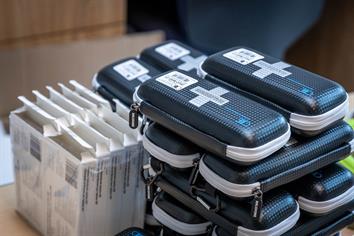In total, 175,022 naloxone kits have been reported distributed to people who use drugs and those who are likely to witness an overdose through the BC Centre for Disease Control’s (BCCDC) Take Home Naloxone program.
”Every free naloxone kit distributed in B.C. is a statement that we are committed as neighbours, as a community, as a province, to saving lives,” said Judy Darcy, Minister of Mental Health and Addictions. “We know that people need to be alive to find their own unique pathway to healing and hope and this announcement tells people using drugs loud and clear that we want them to live.”
The program launched in 2012 and was rapidly scaled up in 2016 in response to the overdose public health emergency. Between 2012 and the end of 2015, 5,073 kits were reported distributed. Since 2016, 169,949 have been given out.

It’s expected that the total number of kits used to reverse an overdose is far greater than the 50,000 reported. The Take Home Naloxone program does not receive data about every kit distributed in the province.
“The Take Home Naloxone program is a crucial component of the emergency response to the overdose crisis in our province and I'm proud of our partners and community members for their dedication and working quickly and creatively to get this life-saving medication into the hands of people who need it,” said Dr. Jane Buxton, harm reduction lead for the BCCDC, the program that runs the Take Home Naloxone program. “However, people need access to a safer supply of substances so they don't use the highly toxic street drugs that puts them at risk of an overdose.”
The Take Home Naloxone program distributes kits throughout British Columbia. There are currently
1,678 active distribution sites including over 700 community pharmacies across the province in all five regional health authorities.
“I’ve been a naloxone trainer for three years and I’ve trained students, foster parents, parole officers and people of the community,” said Paul Choisil, harm reduction leader, peer mentor, and Take Home Naloxone trainer at the Robert & Lilly Lee Community Health Centre and a naloxone trainer at Vancouver Detox. “Everyone who might witness an overdose should carry a naloxone kit because it’s a lifesaving tool. I strongly believe every life matters in our community, too many have died already. You can also make a difference; kits are free.”
People who use drugs are often the first on the scene of an overdose and play a critical role in administering naloxone to save their peers. The Take Home Naloxone program is collaborating with partners to explore novel ways of making the life-saving medication more accessible to people who are likely to witness an overdose.
BCCDC is working with BC Emergency Health Services so paramedics responding to an overdose can provide replacement kits to community members who have used their kit. BC Emergency Health Services paramedics respond to an average of 64 overdose or poisoning calls per day in B.C.; community paramedics also distribute naloxone to patients in their homes or during health information sessions.
BCCDC also provides kits to PHSA’s Corrections Health Services which are distributed to people leaving provincial corrections facilities, a time when they are at higher risk of overdose and overdose death. Approximately 4,500 kits have been distributed through the BC Corrections system.
Quick Facts:
- BCCDC ships between 17,000 and 19,000 Take Home Naloxone kits to registered sites every month.
- Kits are provided to individuals at risk of experiencing an overdose or witnessing and responding to an overdose such as family and friends of someone at risk.
- Take Home Naloxone distribution sites include pharmacies, hospitals and emergency departments, health units and health centres, community sites, corrections facilities, peer-led organizations, paramedics with BC Emergency Health Services, housing sites, friendship centres, post-secondary institutions and treatment facilities.
- Community-based non-profit agencies seeking naloxone for use by staff may be eligible for the Facility Overdose Response Box program.
Note: All Take Home Naloxone program data is accurate as of October 15, 2019.
Learn More:
The BC Centre for Disease Control, a part of the Provincial Health Services Authority, provides public health leadership through surveillance, detection, treatment, prevention and consultation services. The Centre provides diagnostic and treatment services for people with diseases of public health importance, and analytical and policy support to all levels of government and health authorities. The BCCDC also provides health promotion and prevention services to reduce the burden of chronic disease, preventable injury and environmental health risks. For more, visit www.bccdc.ca or follow us on Twitter @CDCofBC.
The Provincial Health Services Authority plans, manages and evaluates selected specialty health care services across BC, working with the five regional health authorities, First Nations Health Authority and the Ministry of Health to deliver province-wide solutions that improve the health of British Columbians. For more information, visit www.phsa.ca or follow us @PHSAofBC.
-30-
Media Contact:
Heather Amos
BCCDC Communications
604.707.2412
or PHSA media line:
778.867.7472
